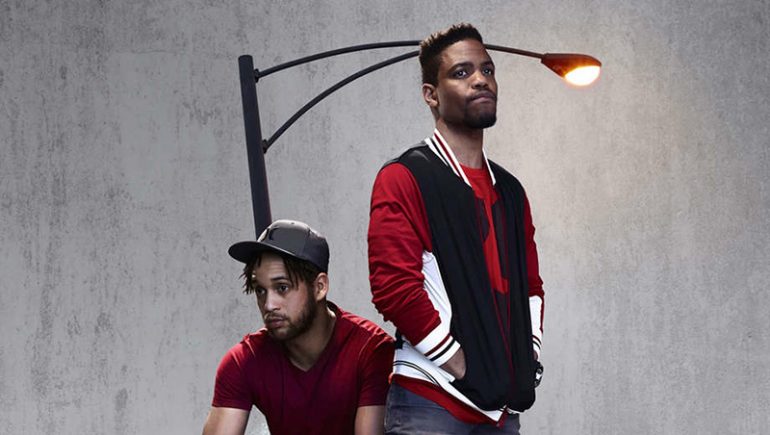Pass Over is a play about two young African-American men on the corner talking jive about their lives. It is a riff on the existential classic, Waiting for Godot.
The playwright is new on the scene. She is a New Yorker, a young African-American woman, Antoinette Nwandu, a graduate of Harvard University.
The play premiered in Chicago at the Steppenwolf. It was a bold and out-of-the-box play for Steppenwolf and it wasn’t for Black History Month.

The play examines questions about escaping mundane, stick in the mud existence. Can these two young Black men dream their way out of their daily predicaments? What do they see? Will the scourges of life pass them over, or will they escape?
This is not a play about hope; this is a play about doom. It is also a play about urban realities for young Black men. That is the power of the play. It is relevant to today. This is about Black America now and Black America’s future as it really exists on American streets for some.
There are some tough realities in this play, which tragically faces a certain population of our society daily that a Black president forgot to address. It shows the symbolic ritual of the Black male interaction with white males; one naively promising, and the other with policemen that can lead to disaster if you, young Black male, make the wrong move, the wrong gesture, at the wrong time.
This is reality, a reality that whites perhaps do not understand, let alone embrace. The Black men are subjected to the psychological cruelty of white policemen daily. Black families teach their sons, no matter their social status, how to be submissive to white male policemen.
The Hedy Weiss Review

Chicago Sun-Times theater critic Hedy Weiss gave the play a lukewarm review, and in her critique basically revealed that she did not understand the reality dilemma of young Black men on the street corner.
She said, “Pass Over was somewhat recommended.” What does that mean? Some said she was racist for that review and others. Clearly there is a bias in her critique, but as a critic, she has the right to say it.
Her review caused an uprising in the theater community. A theater review is valuable to a performance, because it can determine whether the audience comes.
I am weighing in on the discussion and intentionally held my comments until the play ended its run, which it did on Sunday, July 9.
First of all, the play communicates what daily life looks like for some young Black men. This play is geared, I think, for white liberals and would have had a totally different reception at a Black theater company.
The night I went, the audience was mostly comprised of white mid-lifers with a smattering of Blacks, mostly interracial couples at that.
It is a brave endeavor for a white theater company to take on a “Black lifestyle play” in the first place. But it is necessary; this is the place where the art form communicates perhaps better than the classroom or the media. Brave Steppenwolf. Bravo to you.
This is not an easy play because it is real, it is today’s reality, in your face, presented on stage. Hard to take for some, misunderstood by many.
The Critical Review

Some years ago as a publicist, I represented eta Theater (purposely spelled in lowercase letters) located on the South Side of Chicago. My first assignment was to go to the Sun-Times and Tribune to have them take notice of the Black theater company and to review its plays.
eta mostly performed dramas. They totally did not exist for mainstream. My job was to make the company visible to downtown critics. I did all of the proper PR legwork.
The late Chicago Tribune theatre and film critic, Richard Christiansen, agreed to review one of the plays on opening night. But opening night came with a terrible, paralyzing storm. Richard called to say he couldn’t make it. I was working at the time for the late, no-nonsense Abena Joan Brown, who founded eta.
Abena was furious because others made it out despite the weather and she confronted me with, what are you going to do to get him to review the play. I said I couldn’t control the weather.
This is not an easy play because it is real and in your face; hard to take for some, misunderstood by many.
She said angrily that he really didn’t want to come to the South Side in the first place, that my job was to make it happen. Abena did not care whether the review was good or bad.

She cared that the play was reviewed and written about in a “white mainstream newspaper.” It meant money. It meant audience. It meant acceptance.
I reached out again to Mr. Christiansen and this time I provided travel arrangements for him and he made it. I do believe he was afraid to come to the South Side of Chicago; the simple solution was to provide him safe transportation.
Abena and I had many discussions on the “white critic” and Chicago’s theater world. I wondered if downtown critics would understand some of the presentations the company staged. Abena said it was important to spell names right, to provide show times and ticket pricing.
I got eta on the critic review map and eventually it became protocol. I never forgot Abena’s premise. Spell the names right. We built audience and recognition as a legitimate theater company with the “white reviews.”
The Black Critic Is MIA
The problem is that there are few Black theater critics in the first place. The late legendary Earl Calloway of the Chicago Defender was the man about town in the entertainment community.
He appreciated a good performance and seldom wrote a bad review. His philosophy was that it was just too hard for Black theater and Black performers to mount shows in the first place. So Earl would rather just not write about a show than give it a bad review.
At NDIGO, we have multiple Black writers reviewing theater, movies, music, dance, and the rest of the arts and culture that relate to Chicago’s Black community. Off the top of my head, I can’t think of any Black critics who write for mainstream media.
All critics have the right to their subjective opinions. Sometimes things are offensive and race is always one of those things looked at with a jaundiced eye. Is it stereotypical or is it real? Is it history or is it not? The perspective often depends on who was on the giving and receiving ends of that history.
White theater companies have lately been attempting to produce Black plays for their main stage. That concept is interesting all by itself. Can white theater companies tell the Black story or is it just Blackface? Is it a musical or a drama, because they tell different tales?
If you think this is a sensitive matter, you’re darn right that it is. And it is not easy. Chicago’s new theater company, Writers Theater, has approached it correctly; they have incorporated and included Black play subject matter into their season’s portfolio right from the beginning. They do not know what Black History Month is and they advertise all plays everywhere. They are trying to build audience.
Motown vs. Hamilton
I can’t tell you how many times I have argued or presented the case of advertising the white play to Black audiences and vice versa. I am well versed in the argument on both sides.
White folk will never ever understand the real Black story. It is too complex with too many twists and turns. And Blacks may never understand the position of white privilege and power because it has not been ours to behold.
We meet in the middle with the “Cinderella” story and Cinderella is usually white. And then Jackie Taylor turned Cinderella upside down when she cast Cinderella as African American. Call it a gap if you will, but the gap is closing on the theater stage.
Musicals and comedies are most acceptable to all audiences. The Motown Story, for example, was presented to Black and white audiences via the musicality of the story; who doesn’t enjoy Motown’s greatest hits. It ran in a downtown theater and was presented to all audiences for the love of the music.
But with all of its diversity, Hamilton is presented to white downtown audiences exclusively. That means no Black advertising. But when Hamilton brought poor Black kids to the theater for a special performance, N’DIGO was hounded to provide free media coverage of the event.
But until then, we were not contacted at all about the popular Tony Award-winning show, and certainly were not invited to critique the performance itself, even though we have capable Black critics.
We chose not to cover this suspect story of the poor minority kids being brought in to see the play, but the Tribune ran the story on its front page. We did not participate in what we considered a racist public relations strategy.
The Black And White Of It
There is a difference between Black and white theater. Black audiences are sought for the Alvin Ailey Dance Company for example, but not for the Joffrey Ballet. Both are beautiful dance companies.
N’DIGO gets the advertising for the Goodman Theatre’s Black-oriented Objects In The Mirror and August Wilson plays, but not for the Hemingway production. We will get the advertising for the jazz shows at the Chicago Symphony, but not their classic performances. And we get nothing from the Lyric Opera House, even when the opera is Porgy and Bess. Blacks apparently don’t exist and are not invited to that world.
My point is, inherent in the discussion is race baiting. The racial conversation is not just on the stage, or in the critic’s review, or in the audience. It is time to stop it all.
Steppenwolf, which involved itself in the Hedy Weiss discussion, really opened a very wide door on racism at all levels of the world of entertainment, especially in the theater. I hope there are more and similar forums to publicly discuss this issue further.
Hedy Weiss, as a critic, has the right to write what she wants, as long as she remains in that official position. She is powerful because she is one of one. She has shown proclivities to be racially biased in some cases, but probably racially ignorant moreso.
Does anyone think that she really would understand a play about young African-American youth on the corner talking about their sorrowful lives?
Does anyone think white critics truly understand the white policemen’s intimidation tactics with Black boys to make them understand white supremacy? That farce has been going on in urban streets for a hundred years.
What the Steppenwolf’s Pass Over experiences and Hedy Weiss’ review have done is to hold up a mirror to the racism that exists in the theater community. Period.






